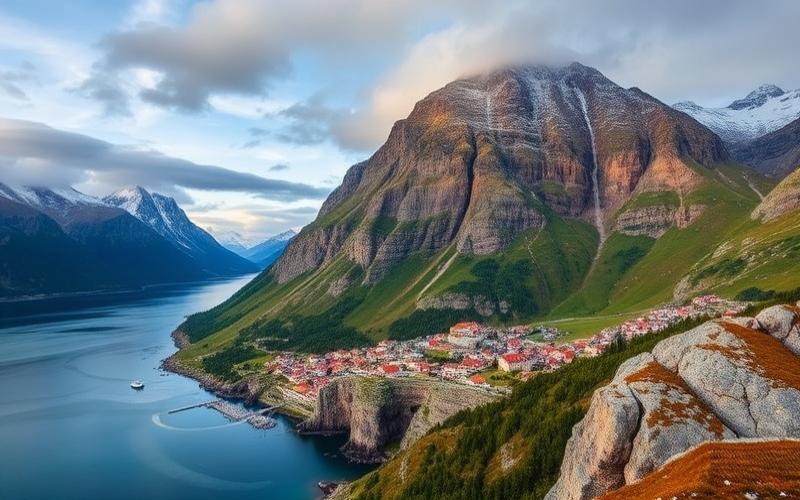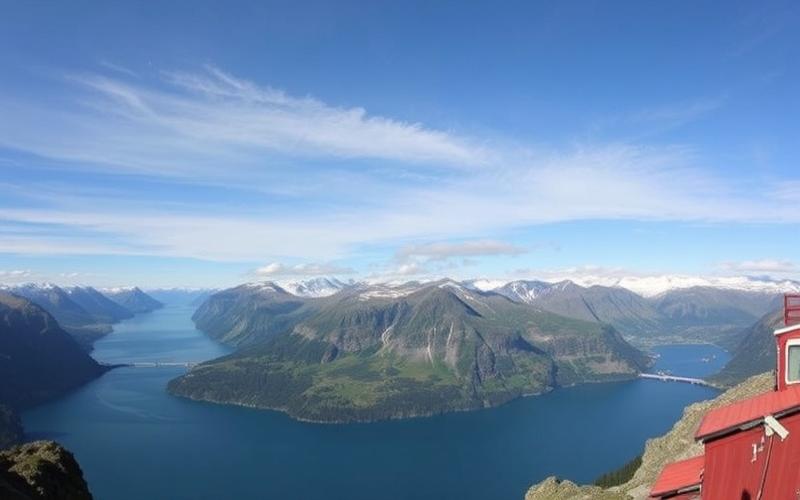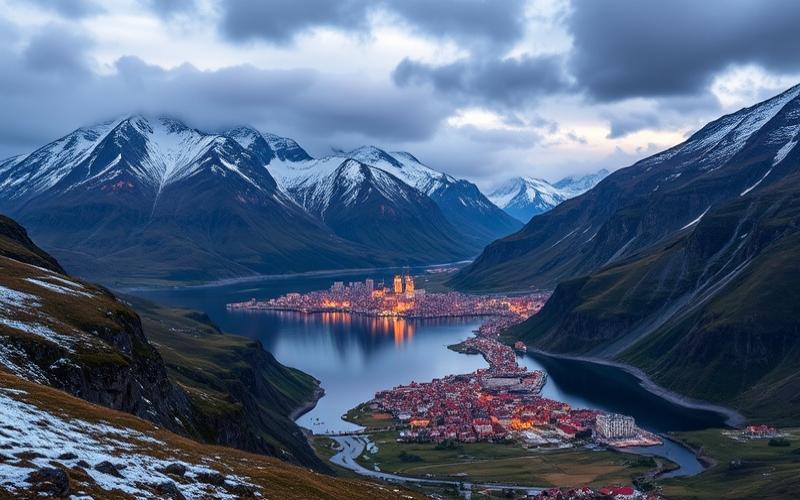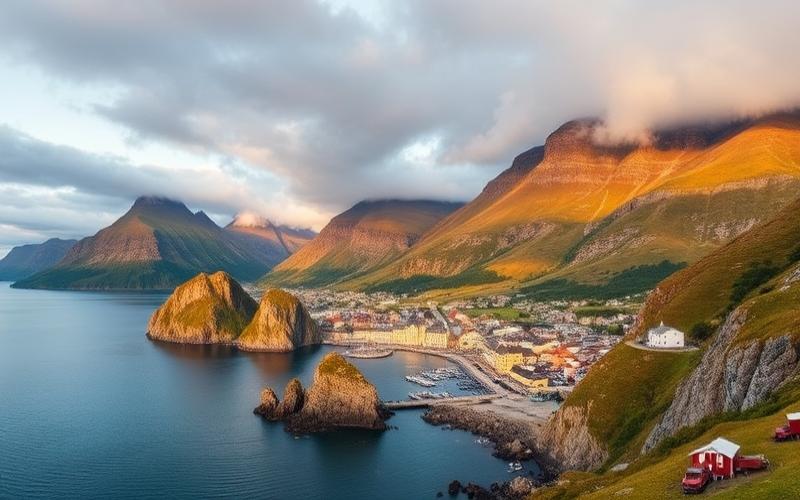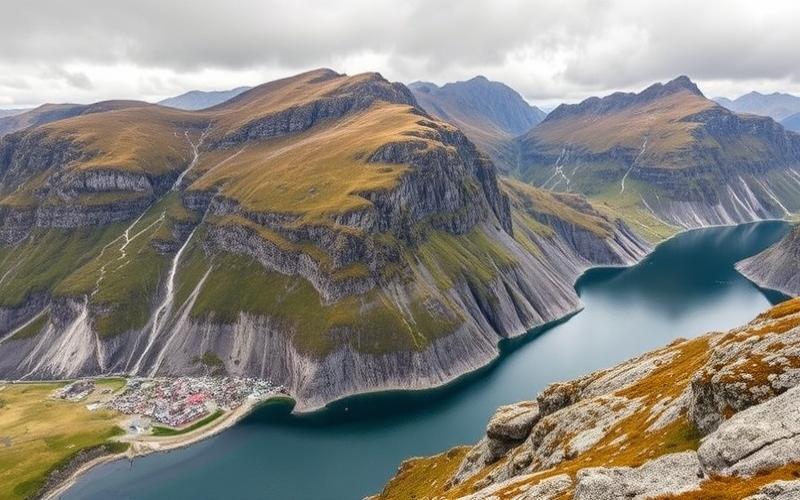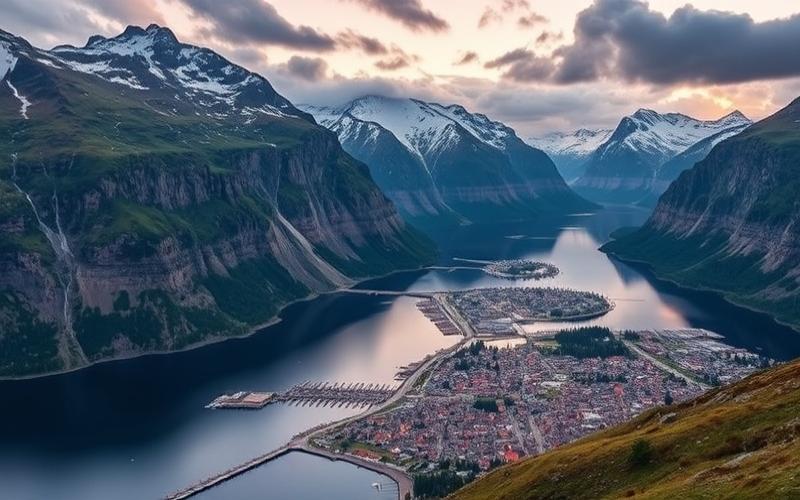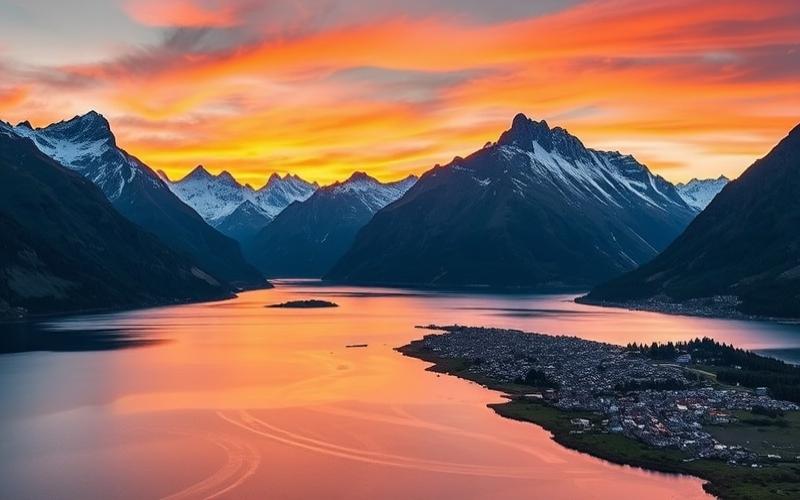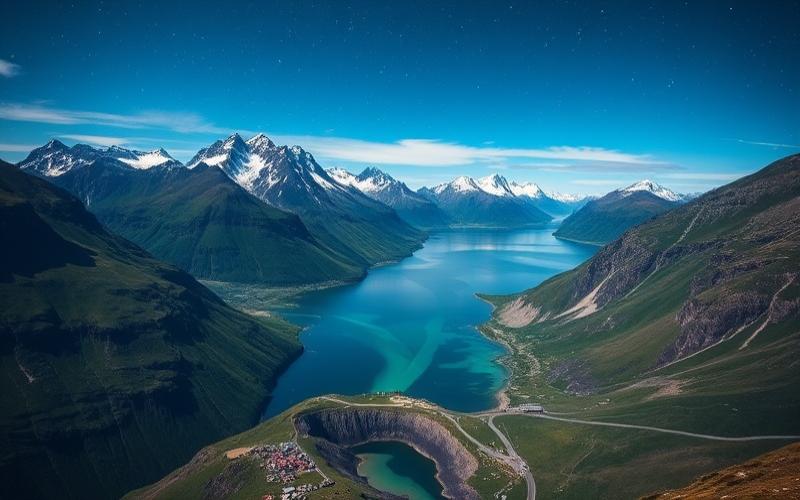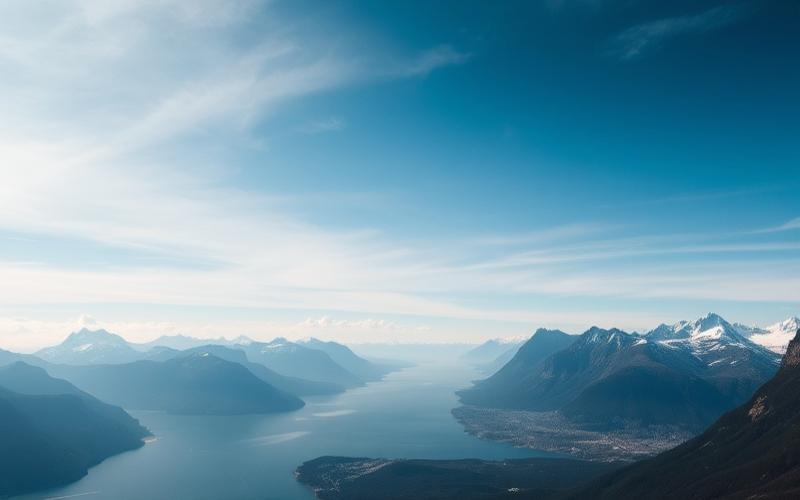
 Published on and written by Cyril Jarnias
Published on and written by Cyril Jarnias
With its breathtaking landscapes and rich culture, Norway stands as a dream destination for travelers seeking new horizons. From the majestic fjords that carve through the coastline to the enchanting Northern Lights that illuminate its Arctic skies, the country offers a multitude of unique attractions.
While wandering through picturesque fishing villages or exploring vast wilderness areas, visitors can immerse themselves in the very essence of Scandinavia.
For those wishing to discover the best Norway has to offer, we’ve compiled a list of must-see tourist sites that captivate and inspire all who visit them.
Norway’s Hidden Treasures: Assets and Challenges
Norway’s hidden treasures extend far beyond its famous fjords and major tourist cities. Among the lesser-known places worth visiting are picturesque villages, remote islands, and preserved national parks.
| Location | Type | Main Assets | Challenges Faced |
|---|---|---|---|
| Stadtlandet & Vågsøy | Coast/islands | Surfing, lighthouses with spectacular views, ancient monastery | Accessibility, limited infrastructure |
| Veitastrond & Jostedalen Valley | Valley/glacier | Rural authenticity, proximity to Jostedalsbreen Glacier | Narrow roads, few tourist services |
| Skudeneshavn | Harbor village | Traditional houses, historic atmosphere | Limited accommodation capacity |
| Vistenfjord | Isolated fjord | Rich biotope, prehistoric human traces | Ecosystem preservation |
| Værlandet Archipelago | Islands | Pristine nature, bird watching, tranquility | Boat access, rare accommodations |
| Senja Island | Arctic island | Varied landscapes, wildlife, less-traveled trails | Short tourist season |
| Hardangervidda National Park | Natural park | Peacefulness, wild reindeer, immense panoramas | Few amenities, harsh weather |
Assets of These Hidden Treasures:
- Authenticity and Local Encounters: Villages like Skudeneshavn or Røros offer immersion in Norwegian culture and traditional life, far from the crowds.
- Untouched Natural Beauty: Remote islands such as Senja or Værlandet, and fjords like Vistenfjord, feature preserved landscapes where nature dominates.
- Unique Experiences: Staying in a lighthouse on Vågsøy, hiking through Hardangervidda among reindeer, or discovering Vingen’s petroglyphs are memorable and rare experiences.
Tourism Promotion Challenges:
- Accessibility: Many of these places are difficult to reach, requiring several hours of driving or boat transfers.
- Lack of Infrastructure: Accommodation and dining options are often limited, which may deter some travelers.
- Ecosystem Preservation: The influx of visitors threatens ecological balance, particularly in isolated fjords or archipelagos home to rare species.
Example Traveler Testimonial:
“We arrived in Veitastrond after a winding road. The village seemed frozen in time, surrounded by mountains and glaciers. The locals invited us to taste their local cheese. We felt truly far from the world, a sense of absolute peace.”
“On Senja Island, I walked for hours without meeting a soul. Only the cries of birds and the wind in the fjords accompanied my hike. These moments of solitude and raw nature remain etched in memory.”
Sustainable Tourism: A Necessity
Preserving these treasures involves limiting human impact: favoring small groups, using eco-friendly accommodations, and respecting local wildlife and flora.
Developing responsible tourism will allow future generations to discover these places in their original state.
List of Best Practices for Sustainable Tourism in Norway:
- Prefer soft transportation methods (train, bicycle, walking).
- Choose accommodations with “green” certifications.
- Respect marked trails and avoid disturbing wildlife.
- Participate in activities led by local guides.
- Support local crafts and production.
Norway off the beaten path reveals a mosaic of landscapes and cultures to preserve with respect and awareness.
Good to Know:
Explore hidden gems like the Lofoten Islands or Rago National Park; although magnificent and authentic, these sites require advance planning due to their limited accessibility and call for sustainable tourism to preserve their untouched beauty.
Journey North: How to Reach Norway’s Wonders
The main access methods to Norway are international flights and ferries. Oslo Gardermoen Airport (OSL) serves as the country’s main gateway, with numerous daily direct flights from major European and global cities. Several airlines operate these routes, offering both direct and connecting options, making Oslo easily accessible year-round. It’s recommended to arrive at the airport at least two hours before a short-haul flight and three hours before a long-haul flight.
For those preferring a slower experience or traveling with their vehicle, ferries connect Norway to other Scandinavian countries, particularly Denmark, Sweden, and Germany. These maritime links offer a scenic alternative for reaching the country while enjoying coastal landscapes.
Transportation for Exploring Norway
After arriving in Norway, several options are available to explore its iconic sites:
| Transportation Method | Advantages | Disadvantages | Ideal For |
|---|---|---|---|
| Train | Comfort, spectacular landscapes, dense network between Oslo, Bergen, Trondheim, etc. | Less flexible for isolated fjords | Visiting major cities, mountain crossings, access to main fjords |
| Bus | Complements rail network, serves remote villages | Sometimes long durations | Access to fjords, villages, rural areas |
| Car Rental | Complete freedom, customized stops | High cost, sometimes narrow roads | Off-the-beaten-path itineraries, fjords, Northern Lights |
| Domestic Ferries | Fjord crossings, unique views | Dependent on schedules | Fjord discovery, connections between shores |
Must-Do Experiences and Practical Tips
- Norwegian Fjords: Train routes (Oslo-Bergen) or car journeys allow discovery of sites like Geirangerfjord or Sognefjord. Local cruises offer unique perspectives on these landscapes.
- Northern Lights: The northern part of the country (Tromsø, Lofoten) is ideal from September to March. Prefer car rental or organized tours to maximize observation chances.
- Historic Cities: Bergen, with its UNESCO-listed harbor, and Trondheim, the former royal capital, are easily accessible by train or domestic flight.
Best Times to Visit
- Fjords: May to September (mild climate, long days)
- Northern Lights: September to March (long nights and clear skies)
- Hiking and Nature: June to August (optimal mountain conditions)
Tourist Infrastructure
- Accommodation: Wide choice, from modern city hotels to traditional cabins (“hytter”) in nature. Advance booking recommended during high season.
- Transportation: Modern rail network, frequent buses, well-maintained roads. Domestic ferries complement offerings in fjord regions.
Unique Experiences to Live in Norway
- Fjord cruise at sunrise or sunset.
- Night in an ice hotel or forest cabin.
- Encounter with Sami culture and discovery of northern traditions.
- Hiking on scenic trails like Preikestolen or Trolltunga.
Respect and Preservation
Norway demands nature respect: take your trash back, stay on marked trails, respect wildlife and flora. The right to access nature (“allemannsretten”) allows free enjoyment of natural spaces while remaining responsible.
Traveling in Norway means exploring breathtaking landscapes while committing to preserve this exceptional nature for future generations.
Good to Know:
International flights mainly land in Oslo, from where you can reach must-see sites by train or bus; ferries are also an option from other Scandinavian countries. To explore fjords and observe Northern Lights, prefer traveling between May and September, and remember to book accommodations in advance due to tourist influx.
Unforgettable Stay: Tips for Accommodation in Norway
In Norway, accommodation options are varied, suited to all budgets and preferences. Here’s an overview of main options and valuable tips to optimize your experience.
| Accommodation Type | Main Characteristics | Price Range (Indicative) | Recommended Period |
|---|---|---|---|
| Hotels | Modern comfort, full services (breakfast, spa, etc.), from luxury to budget | 800-4000 NOK/night | Year-round, high demand in summer |
| Hostels | Dorms or private rooms, shared facilities, friendly atmosphere | 250-600 NOK/night | Mainly June-August, some year-round |
| Guesthouses/B&Bs | Warm welcome, often family-run, breakfast included or optional, shared or private bathroom | 450-900 NOK/night | High season (summer), but also winter |
| Airbnb / Homestays | Apartments, studios or private rooms, local immersion, independence | 300-2000 NOK/night | Year-round, increase in summer |
| Traditional Cabin (hytte) | Small wooden house, often in nature or campgrounds, ideal for authentic Norwegian experience | 400-1500 NOK/night | Spring to fall, skiing in winter |
| Unique Stays | Lighthouses, treehouses, rorbuer (fishermen’s cabins), ice hotels | 1000-5000 NOK/night | Depending on availability, marked seasonality |
| Camping | Tent sites, caravan or bungalow, often with restrooms and shared kitchen | 150-600 NOK/night | May to September |
Unique and Authentic Options
- Hytte: These traditional cabins offer immersion in Norwegian nature, near fjords, lakes or mountains. Often rustic but comfortable, they’re highly prized for their cozy atmosphere.
- Rorbuer: Former fishermen’s houses, particularly present in Lofoten, perfect for waterfront stays.
- Lighthouse or Ice Hotel: For an extraordinary night, some decommissioned lighthouses or ephemeral ice hotels welcome travelers seeking originality.
- Homestays: Through Airbnb or other platforms, living with locals allows daily discovery of local culture.
Seasonality and Price Variations
- High Season: From June to August, prices rise, especially in tourist regions (fjords, Lofoten, major cities). Accommodations fill quickly, better to book several months in advance.
- Low Season: Between October and April, milder prices outside school holidays, except in winter sports areas (ski resorts, Tromsø for Northern Lights).
- Year-End Holidays and Festivals: Anticipate reservations as demand spikes locally.
Practical Tips for Saving Money
- Book Early: The earlier you book, the wider the choice and better prices, especially in summer.
- Prefer Hostels, Camping or Hytter: Ideal for small budgets, with possibility to cook on site.
- Travel in Groups: Renting a cabin or apartment together reduces cost per person.
- Opt for Low Season: To benefit from attractive rates and avoid crowds.
- Compare Platforms: Airbnb, Booking, local sites, and consult tourist offices for hytter rentals.
Recommended Regions by Tourist Sites
| Region | Tourist Assets | Stay Advantages |
|---|---|---|
| Oslo | Capital, museums, cultural life | Easy access, varied accommodation choices |
| Bergen | Old town, fjord access, harbor | Ideal for exploring Western fjords |
| Tromsø | Northern Lights observation, nature | Starting point for the Far North |
| Lofoten/Vesterålen | Spectacular landscapes, fishing villages | Rorbuer, cabins, total immersion |
| Fjord Region | Geiranger, Sognefjord, Hardangerfjord | Numerous chalets, hotels with views |
Key Takeaways
For an unforgettable stay in Norway, vary your accommodations, prioritize advance bookings, and dare to try authentic options like hytter or homestays. The diversity of lodgings allows tailoring your trip to every desire and budget.
Good to Know:
For a stay in Norway, explore hostels for budget options, but opt for traditional cabins or homestays for authentic immersion; book in advance, especially during high season, to benefit from advantageous prices near fjords or Northern Lights. For the best value, prefer guesthouses in Oslo or Bergen, and consider Airbnb for a unique local touch.
Disclaimer: The information provided on this website is for informational purposes only and does not constitute financial, legal, or professional advice. We encourage you to consult qualified experts before making any investment, real estate, or expatriation decisions. Although we strive to maintain up-to-date and accurate information, we do not guarantee the completeness, accuracy, or timeliness of the proposed content. As investment and expatriation involve risks, we disclaim any liability for potential losses or damages arising from the use of this site. Your use of this site confirms your acceptance of these terms and your understanding of the associated risks.


